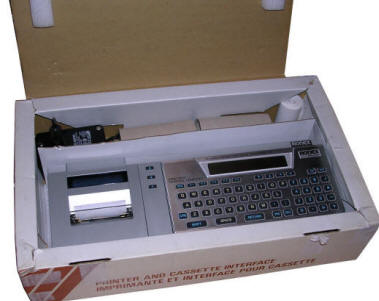Ronex (Sanco) TPC-8300
Introduced in early 1983 (or late 1982) Sanco TPC-8300
was a pocket-size microcomputer or programmable calculator, which can be
programmed in BASIC language. It has built-in LCD (2x 24 characters) and
possibility to connect to docking station containing printer and
additional interfaces. The computer is built around NEC uPD78C06 8-bit
microprocessor and has 16kB of ROM containing BASIC and 2kB (?4KB) of
CPU's built-in ROM. All components are in CMOS low-power technology
allowing the computer to be powered from AA batteries. It was probably
made by Sanyo or Alps.
Docking station contains tape and parallel interfaces and a special type
of printer which uses revolving head with small ballpens. Head is moving
horizontally, while paper can move vertically. Small solenoid presses
ballpen to paper giving print-out. Such mechanism can change ballpen
colors by shifting head to the left, where it is revolved. In its right
side, user may remove small ballpens using special lever. Docking
station is powered by power supply or built-in Ni-Cd battery.
This machine has been sold as Sanco TPC-8300 in France and probably in
Germany (According to this
page, Sanco was French Sanyo's distributor and one more company),
and as Ronex in Sweden and Norway (see the
advertisement). Ronex unit is the same as Sanco, it has only
different brand. Another rebranding was in Switzerland, where it was
sold as Migros M-Office HHC2000.
| Manufacturer | Ronex | |
| Origin | Japan | |
| Year of unit | 1983 | |
| Year of introduction | 1982 | |
| End of production | ?1988? | |
| CPU | NEC upD78C06 | |
| Speed | 1MHz? | |
| RAM | 6kB | |
| ROM | 16kB + 2kB | |
| Colors: | Monochrome | |
| Sound: | Beeper | |
| OS: | BASIC | |
| Display modes: | Text on LCD: 24x2 | |
| Media: | Tape recorder | |
|
Power supply: |
||
|
Or 4 AA batteries. To work with printer, it is important to power both CPU and dock. CPU may be powered from batteries, so power supply goes to dock. |
||
| I/O: | Expansion port Dock connector Paralell port (in the dock) Tape I/O (in the dock) |
|
| Possible upgrades: | Possible | |
| Accessories in collection: - Original docking station, power suply unit, box |
||
| Software accessibility: | Difficult |
My unit is in a very good condition, fully working, it arrived with English and Swedish manuals, power supply and box. There is also a booklet, probably in Swedish language, with programs dated ca. 1983, but some of them look incomplete.
Here you can see review, it's in French and comes from some kind of magazine about small computers.
| Contents: | Starting | Recording media | Pinouts | Links |
Starting:
If you want to run computer with dock, you need power
both for computer and dock. Computer may be operating on batteries while
in a dock.
Remember that dock contains Ni-Cd rechargeable battery (4.8V, 500mAh)
which, after 30 years usually leaks. If you have such computer, remember
to remove the battery.
Printer
To replace ball pens, turn the computer on and press "P" key on printer.
The head will shift to the right when you may press lever to remove ball
pen. Original, metal ones seem not to be refillable. To change next pen,
press any "paper move" button and rotate the revolving part of carrier,
then "P" key again.
To fit paper, load it on the back, pressing "paper advance" button.
Everything is explained in manual.
BASIC
The computer starts directly to BASIC. With default configuration, the
first LCD's line contains your program and can be edited, while second
contains keywords accessible form F-keys. Now you can type your programs
and run them. Remember that while DEL deletes a character, typing
another one will not insert, but overwrite. To insert character, press
INS key. If you can't break an infinite loop you made in your program,
use "Reset" button on the back of computer (clears everything). Here are
the most important BASIC commands:
CONSOLE x,y
if x=0, no sound, x=1 - pressing keys generates short sound. y turns
the bottom line (containing hints for Fx keys) on and off.
NEW
Clears program and variables.
These commands will be useful when working with docking station:
CLOAD "program"
Loads program named program from cassette. You have to specify this
name in full.
CLOAD? "program"
Verifies program named "program" on cassette vs program in memory.
Useful when you dump software from computer.
CSAVE "program"
Saves program with name "program" on cassette. Remember that output
level of tape output on this computer is really low.
LPRINT "test"
Prints "test" text on the printer.
Recording media
Currently (2016) there seems to be no method to retrieve
data from recordings. It is possible to replay programs recorded as WAVs
successfully. 22050Hz sample rate at 8-bit is enough to hold data.
Remember that after recording in computer, you usually will have to
amplify the sound because output level of docking station is very small.
To verify, there are two programs in my fileland. I've typed them and
tested, they load from sound card. If they don't, perform standard
volume level checks.
Pinouts:
Parallel port (according to manual) Connector: Centronics, 24-pin:
1 - /STROBE
2 - DATA 1
3 - DATA 2
4 - DATA 3
5 - DATA 4
6 - DATA 5
7 - DATA 6
8 - DATA 7
9 - DATA 8
10 - ?nc?
11 - BUSY
13-23 - GND
24 - SENSE
SENSE pin is made to bypass built-in printer and use parallel one instead. When parallel port peripheral is connected, it is shorted to GND.
Links:
http://mycalcdb.free.fr/main.php?l=0&id=1527 - In old calculators
museum, lots of photos.
http://pockemul.free.fr/ - This
emulator can emulate it.





